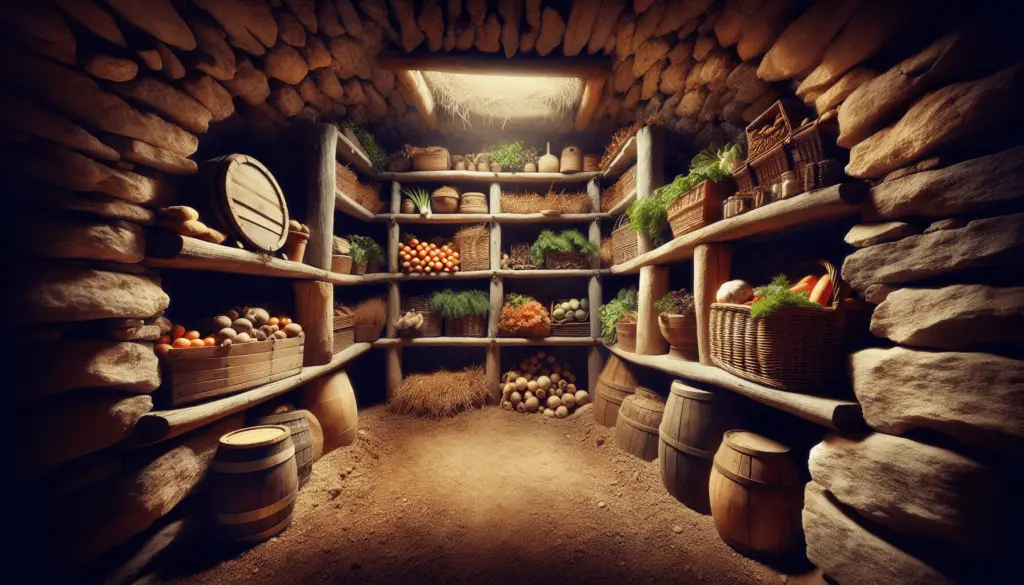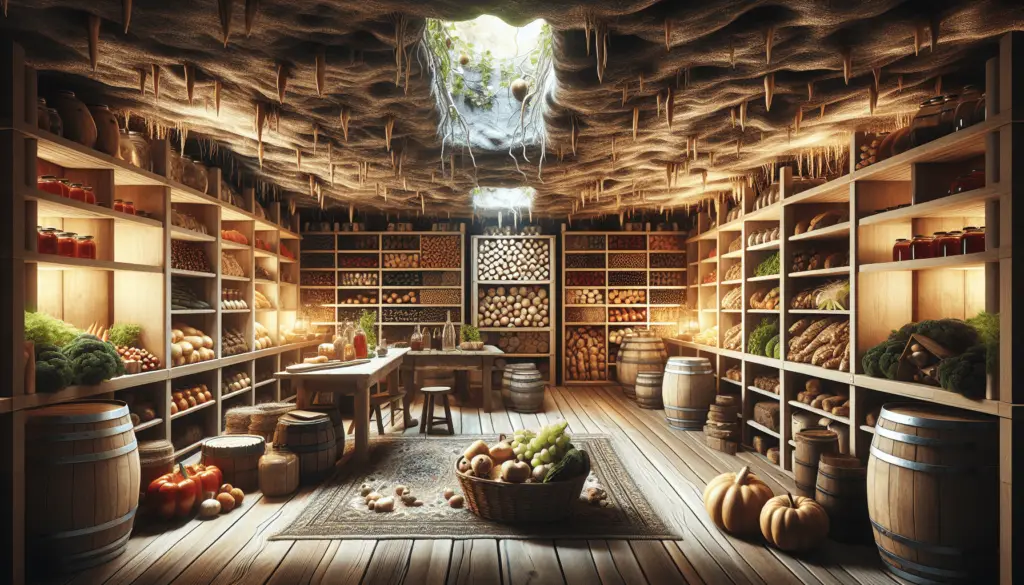If you have ever dreamed of having a backyard filled with fresh produce all year round, then building an underground root cellar might just be the solution you’ve been searching for. From preserving your harvest to providing a cool and dark space for storing perishable items, a root cellar can be an invaluable asset to any garden enthusiast. But before you start excavating, there are a few key considerations that you should keep in mind to ensure the success of your underground storage space.
Location
Proximity to the House
When building an underground root cellar, it is important to consider its proximity to your house. Having it located near your home will make it more convenient for you to access and retrieve stored items, especially during inclement weather. Additionally, having the root cellar close by will make it easier to transfer fresh produce and other perishable items from your garden or kitchen directly to the cellar.
Drainage
Another crucial consideration when choosing the location for your underground root cellar is drainage. You want to ensure that the area where you plan to build it has good drainage to prevent any waterlogging issues. If the chosen location tends to collect water or is prone to flooding, it may be necessary to implement proper drainage systems or choose an alternative location to avoid potential damage to your root cellar and its contents.
Accessibility
Accessibility is a key factor to consider when planning for your underground root cellar. You want to make sure that the cellar is easily accessible for you to store and retrieve your items. It is advisable to design the entrance in a way that allows easy movement of produce in and out of the cellar. This might include making the entrance wide enough for comfortable passage and ensuring that it is at a convenient height to minimize strain during loading and unloading activities.
Size and Design
Determining the Size
The size of your underground root cellar will depend on several factors, including the amount of produce or items you plan to store. Consider your family’s needs, the size of your garden, and the frequency of grocery shopping when determining the size of your cellar. It is important to allow for future expansion as your needs may change over time. Remember to also consider the height of the cellar to accommodate taller items such as hanging baskets or shelves.
Design Considerations
When it comes to the design of your underground root cellar, there are a few important considerations to keep in mind. A well-designed cellar should maximize storage space while ensuring proper airflow and insulation. Consider using shelves, racks, or bins to organize items and make the most of the available space. Additionally, you may want to consider incorporating separate sections or compartments within the cellar to store different types of produce.
Ventilation
Proper ventilation is crucial for maintaining the ideal conditions inside your root cellar. Adequate airflow helps prevent the buildup of excess moisture and prevents the growth of mold or mildew. Consider incorporating ventilation systems such as vents or air ducts to ensure a constant flow of fresh air. Additionally, adjustable ventilation options allow you to control the temperature and humidity levels inside the cellar.

Materials
Choosing the Right Materials
Selecting the right materials for your underground root cellar is essential to ensure durability and longevity. Opt for materials that are resistant to moisture, rot, and pests. Common choices include concrete, stone, or brick for the structure, as they offer excellent insulation and protection against the external environment. Additionally, consider using water-resistant paints or coatings to further protect the cellar’s walls and surfaces.
Insulation
Insulation plays a critical role in maintaining optimal temperature and humidity levels within your root cellar. Choose insulation materials that are effective in trapping and regulating temperature, such as foam board insulation or insulating panels. Proper insulation not only helps prevent heat loss but also protects your stored items from extreme temperature fluctuations.
Waterproofing
Since an underground root cellar is susceptible to moisture from the ground, proper waterproofing is vital. Ensure that the chosen materials for the cellar’s construction are waterproof or can be adequately sealed to prevent water seepage. Additionally, consider incorporating a moisture barrier or using waterproof coatings on the cellar’s walls and flooring to provide an extra layer of protection against moisture ingress.
Structural Considerations
Supporting the Ceiling and Walls
The structural integrity of your underground root cellar is of utmost importance to ensure its longevity and safety. Properly supporting the ceiling and walls is crucial, especially when constructing it in areas with unstable soil or high water tables. Consult with a qualified contractor or structural engineer to determine the appropriate support systems, such as beams or reinforced walls, to enhance the cellar’s stability and prevent any potential collapse.
Flooring
Choosing the right flooring for your root cellar is essential to maintain a clean and functional space. Consider using materials that are moisture-resistant and easy to clean, such as concrete, tile, or durable epoxy coatings. These materials offer the advantage of being resistant to rot, pest infestations, and moisture-related damages.
Entrance Design
The design of the entrance to your underground root cellar should take into account ease of use, proper sealability, and security. Consider installing a sturdy door that can be tightly sealed to prevent heat loss and the entry of pests. Ensure the entrance is wide enough for easy access and equipped with a reliable locking mechanism to enhance security. Incorporating steps or a ramp can also facilitate safe and convenient entry.

Temperature and Humidity Control
Temperature Regulation
Maintaining a consistent temperature is vital for the proper storage of perishable items in your underground root cellar. Consider implementing a temperature regulation system, such as a thermostat-controlled ventilation or cooling system. This will help ensure that the temperature stays within the recommended range for storing various fruits, vegetables, and other sensitive perishables.
Humidity Control
Proper humidity control is essential to prevent excess moisture buildup or drying out of your stored items. Incorporate a humidity control system in your root cellar, such as dehumidifiers or humidity sensors, to maintain an optimal humidity level. This will help extend the shelf life of your produce and prevent the growth of mold or bacterial decay.
Lighting
Natural Lighting
While underground root cellars are meant to be dark, natural lighting can still be beneficial for certain purposes. Consider incorporating small windows or light tubes to allow for a minimal amount of natural light. Natural lighting can help with visibility when organizing or searching for items. However, it is crucial to ensure that the windows or light tubes are properly sealed to prevent heat loss and maintain insulation.
Artificial Lighting
Since natural lighting may not be sufficient, especially during cloudy days or at night, artificial lighting is essential in your underground root cellar. Opt for energy-efficient lighting options, such as LED lights, which provide bright illumination while consuming less energy. Make sure to position the lights strategically to evenly distribute light throughout the cellar, ensuring visibility in all areas.
Security
Door Locks
Securing your underground root cellar is important to prevent unauthorized access and protect your stored items. Choose high-quality door locks that are resistant to tampering or forced entry. Consider installing deadbolt locks or electronic lock systems for added security. Regularly inspect and maintain the door locks to ensure proper functioning.
Rodent and Pest Control
Rodents and pests can pose a significant threat to the contents of your root cellar. Implement effective pest control measures, such as sealing any gaps or cracks, using screens on vents, and setting up traps or baits when necessary. Regularly inspect the cellar for signs of pest activity and take prompt action to prevent any infestations.
Organization and Shelving
Storage Racks and Shelves
Proper organization is key to maximizing the storage space in your underground root cellar. Install sturdy storage racks or shelves that can withstand the weight of your stored items. Consider adjustable shelves to accommodate varying sizes of produce and allow flexibility in storage arrangements. Utilize vertical space by incorporating hanging baskets or racks for items such as onions or garlic.
Proper Labeling
To maintain an organized and efficient root cellar, labeling is essential. Properly label each item or container with its name and date of storage. This helps you easily identify and locate specific items when needed, minimizing the time spent searching for particular produce. Utilize waterproof labels or markers to ensure legibility and prevent smudging due to condensation or moisture.
Maintenance and Cleaning
Regular Inspections
Regular inspections are crucial to identify any maintenance issues or potential hazards in your underground root cellar. Periodically check for signs of water seepage, cracks in the walls or flooring, and pest activity. Ensure that ventilation systems and temperature control equipment are functioning optimally. Promptly address any issues to prevent further damage or compromise the integrity of the cellar.
Cleaning Techniques
Maintaining a clean root cellar is essential for preventing mold, bacterial growth, and foul odors. Regularly clean the cellar’s surfaces with mild cleaning agents or disinfectants. Avoid using harsh chemicals that may contaminate your stored produce. Pay particular attention to cleaning areas prone to spills or moisture buildup. Properly dispose of any spoiled or decaying items to prevent the spread of mold or pests.
Backup Systems
Alternative Cooling Methods
Having backup cooling methods in place is crucial in the event of cooling system failures or power outages. Consider alternative cooling options such as evaporative cooling or maintaining a supply of ice packs or blocks. These can help regulate the temperature until regular cooling systems are restored, preventing spoilage of your stored items.
Emergency Power Supply
To ensure adequate power supply during power outages, it is advisable to have an emergency backup power system for your underground root cellar. Invest in a generator or consider installing a battery backup system. This will help maintain the operation of essential equipment such as cooling systems, ventilation, and lighting, ensuring the preservation of your stored produce even during unexpected power disruptions.
Building an underground root cellar requires careful consideration of various factors. From the location and size to materials, ventilation, and security, each aspect contributes to creating a functional and efficient storage space for your produce. By following these key considerations and implementing appropriate systems, your underground root cellar can provide long-lasting storage and help extend the shelf life of your fruits, vegetables, and other perishable items.
